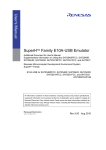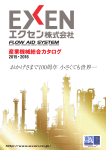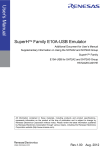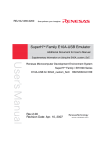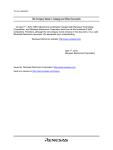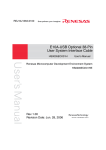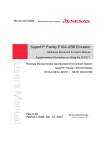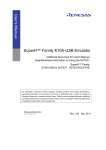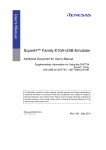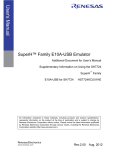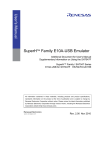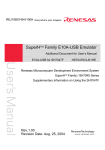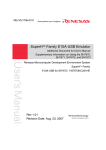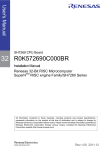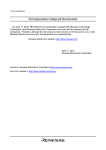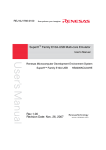Download SuperH Family E10A-USB Emulator Additional Document for User`s
Transcript
User’s Manual SuperH™ Family E10A-USB Emulator Additional Document for User’s Manual Supplementary Information on Using the SH7256R Group SH72567R and SH72567BFCC SuperH™ Family E10A-USB for SH7256R Group SH72567R, SH72567BFCC HS7256KCU01HE All information contained in these materials, including products and product specifications, represents information on the product at the time of publication and is subject to change by Renesas Electronics Corporation without notice. Please review the latest information published by Renesas Electronics Corporation through various means, including the Renesas Electronics Corporation website (http://www.renesas.com). www.renesas.com Rev.1.00 Aug. 2012 Notice 1. Descriptions of circuits, software and other related information in this document are provided only to illustrate the operation of semiconductor products and application examples. You are fully responsible for the incorporation of these circuits, software, and information in the design of your equipment. Renesas Electronics assumes no responsibility for any losses incurred by you or third parties arising from the use of these circuits, software, or information. 2. Renesas Electronics has used reasonable care in preparing the information included in this document, but Renesas Electronics does not warrant that such information is error free. Renesas Electronics assumes no liability whatsoever for any damages incurred by you resulting from errors in or omissions from the information included herein. 3. Renesas Electronics does not assume any liability for infringement of patents, copyrights, or other intellectual property rights of third parties by or arising from the use of Renesas Electronics products or technical information described in this document. No license, express, implied or otherwise, is granted hereby under any patents, copyrights or other intellectual property rights of Renesas Electronics or others. 4. You should not alter, modify, copy, or otherwise misappropriate any Renesas Electronics product, whether in whole or in part. Renesas Electronics assumes no responsibility for any losses incurred by you or third parties arising from such alteration, modification, copy or otherwise misappropriation of Renesas Electronics product. 5. Renesas Electronics products are classified according to the following two quality grades: “Standard” and “High Quality”. The recommended applications for each Renesas Electronics product depends on the product’s quality grade, as indicated below. “Standard”: Computers; office equipment; communications equipment; test and measurement equipment; audio and visual equipment; home electronic appliances; machine tools; personal electronic equipment; and industrial robots etc. “High Quality”: Transportation equipment (automobiles, trains, ships, etc.); traffic control systems; anti-disaster systems; anticrime systems; and safety equipment etc. Renesas Electronics products are neither intended nor authorized for use in products or systems that may pose a direct threat to human life or bodily injury (artificial life support devices or systems, surgical implantations etc.), or may cause serious property damages (nuclear reactor control systems, military equipment etc.). You must check the quality grade of each Renesas Electronics product before using it in a particular application. You may not use any Renesas Electronics product for any application for which it is not intended. Renesas Electronics shall not be in any way liable for any damages or losses incurred by you or third parties arising from the use of any Renesas Electronics product for which the product is not intended by Renesas Electronics. 6. You should use the Renesas Electronics products described in this document within the range specified by Renesas Electronics, especially with respect to the maximum rating, operating supply voltage range, movement power voltage range, heat radiation characteristics, installation and other product characteristics. Renesas Electronics shall have no liability for malfunctions or damages arising out of the use of Renesas Electronics products beyond such specified ranges. 7. Although Renesas Electronics endeavors to improve the quality and reliability of its products, semiconductor products have specific characteristics such as the occurrence of failure at a certain rate and malfunctions under certain use conditions. Further, Renesas Electronics products are not subject to radiation resistance design. Please be sure to implement safety measures to guard them against the possibility of physical injury, and injury or damage caused by fire in the event of the failure of a Renesas Electronics product, such as safety design for hardware and software including but not limited to redundancy, fire control and malfunction prevention, appropriate treatment for aging degradation or any other appropriate measures. Because the evaluation of microcomputer software alone is very difficult, please evaluate the safety of the final products or systems manufactured by you. 8. Please contact a Renesas Electronics sales office for details as to environmental matters such as the environmental compatibility of each Renesas Electronics product. Please use Renesas Electronics products in compliance with all applicable laws and regulations that regulate the inclusion or use of controlled substances, including without limitation, the EU RoHS Directive. Renesas Electronics assumes no liability for damages or losses occurring as a result of your noncompliance with applicable laws and regulations. 9. Renesas Electronics products and technology may not be used for or incorporated into any products or systems whose manufacture, use, or sale is prohibited under any applicable domestic or foreign laws or regulations. You should not use Renesas Electronics products or technology described in this document for any purpose relating to military applications or use by the military, including but not limited to the development of weapons of mass destruction. When exporting the Renesas Electronics products or technology described in this document, you should comply with the applicable export control laws and regulations and follow the procedures required by such laws and regulations. 10. It is the responsibility of the buyer or distributor of Renesas Electronics products, who distributes, disposes of, or otherwise places the product with a third party, to notify such third party in advance of the contents and conditions set forth in this document, Renesas Electronics assumes no responsibility for any losses incurred by you or third parties as a result of unauthorized use of Renesas Electronics products. 11. This document may not be reproduced or duplicated in any form, in whole or in part, without prior written consent of Renesas Electronics. 12. Please contact a Renesas Electronics sales office if you have any questions regarding the information contained in this document or Renesas Electronics products, or if you have any other inquiries. (Note 1) “Renesas Electronics” as used in this document means Renesas Electronics Corporation and also includes its majorityowned subsidiaries. (Note 2) “Renesas Electronics product(s)” means any product developed or manufactured by or for Renesas Electronics. (2012.4) Regulatory Compliance Notices European Union regulatory notices This product complies with the following EU Directives. (These directives are only valid in the European Union.) CE Certifications: • Electromagnetic Compatibility (EMC) Directive 2004/108/EC EN 55022 Class A WARNING: This is a Class A product. In a domestic environment this product may cause radio interference in which case the user may be required to take adequate measures. EN 55024 • Information for traceability • Authorised representative Name: Renesas Electronics Corporation Address: 1753, Shimonumabe, Nakahara-ku, Kawasaki, Kanagawa, 211-8668, Japan • Manufacturer Name: Renesas Solutions Corp. Address: Nippon Bldg., 2-6-2, Ote-machi, Chiyoda-ku, Tokyo 100-0004, Japan • Person responsible for placing on the market Name: Renesas Electronics Europe Limited Address: Dukes Meadow, Millboard Road, Bourne End, Buckinghamshire, SL8 5FH, U.K. Environmental Compliance and Certifications: • Waste Electrical and Electronic Equipment (WEEE) Directive 2002/96/EC WEEE Marking Notice (European Union Only) Renesas development tools and products are directly covered by the European Union's Waste Electrical and Electronic Equipment, (WEEE), Directive 2002/96/EC. As a result, this equipment, including all accessories, must not be disposed of as household waste but through your locally recognized recycling or disposal schemes. As part of our commitment to environmental responsibility Renesas also offers to take back the equipment and has implemented a Tools Product Recycling Program for customers in Europe. This allows you to return equipment to Renesas for disposal through our approved Producer Compliance Scheme. To register for the program, click here “http://www.renesas.com/weee". United States Regulatory notices on Electromagnetic compatibility FCC Certifications (United States Only): This equipment has been tested and found to comply with the limits for a Class A digital device, pursuant to Part 15 of the FCC Rules. These limits are designed to provide reasonable protection against harmful interference when the equipment is operated in a commercial environment. This equipment generates, uses, and can radiate radio frequency energy and, if not installed and used in accordance with the instruction manual, may cause harmful interference to radio communications. Operation of this equipment in a residential area is likely to cause harmful interference in which case the user will be required to correct the interference at his own expense. CAUTION: Changes or modifications not expressly approved by the party responsible for compliance could void the user's authority to operate the equipment. Table of Contents Section 1 Connecting the Emulator with the User System .................................................................... 1 1.1 1.2 1.3 1.4 1.5 Components of the Emulator .................................................................................................................................... 1 Connecting the Emulator with the User System ....................................................................................................... 3 Installing the H-UDI Port Connector on the User System ........................................................................................ 4 Pin Assignments of the H-UDI Port Connector ........................................................................................................ 5 Recommended Circuit between the H-UDI Port Connector and the MCU .............................................................. 9 1.5.1 Recommended Circuit (36-Pin Type) ............................................................................................................ 9 1.5.2 Recommended Circuit (14-Pin Type) .......................................................................................................... 11 1.5.3 Recommended Circuit (38-Pin Type) .......................................................................................................... 14 Section 2 Software Specifications when Using the Emulator ............................................................. 17 2.1 2.2 Differences between the SH7256R and the Emulator............................................................................................. 17 Specific Functions for the Emulator when Using the SH7256R............................................................................. 23 2.2.1 Intelligent Flash Security (IFS): Setting and Resetting of Key Codes ......................................................... 23 2.2.2 Event Condition Functions ........................................................................................................................... 28 2.2.3 Trace Functions ............................................................................................................................................ 35 2.2.4 Notes on Using the JTAG (H-UDI) Clock (TCK)........................................................................................ 42 2.2.5 Notes on Setting the [Breakpoint] Dialog Box............................................................................................. 42 2.2.6 Notes on Setting the [Event Condition] Dialog Box and the BREAKCONDITION_ SET Command........ 43 2.2.7 Emulation RAM Setting Function................................................................................................................ 43 SuperH™ Family E10A-USB Emulator Section 1 Connecting the Emulator with the User System Section 1 Connecting the Emulator with the User System 1.1 Components of the Emulator The E10A-USB emulator supports the SH7256R Group. Table 1.1 lists the components of the emulator. R20UT2167EJ0100 Rev. 1.00 Aug 09, 2012 Page 1 of 46 SuperH™ Family E10A-USB Emulator Section 1 Connecting the Emulator with the User System Table 1.1 Components of the Emulator Classification Component Hardware Emulator box Appearance Quantity 1 Remarks HS0005KCU01H: Depth: 65.0 mm, Width: 97.0 mm, Height: 20.0 mm, Mass: 72.9 g or HS0005KCU02H: Depth: 65.0 mm, Width: 97.0 mm, Height: 20.0 mm, Mass: 73.7 g Software User system interface cable 1 14-pin type: Length: 20 cm, Mass: 33.1 g User system interface cable 1 36-pin type: Length: 20 cm, Mass: 49.2 g (only for HS0005KCU02H) USB cable 1 Length: 150 cm, Mass: 50.6 g E10A-USB emulator setup program, TM SuperH Family E10AUSB Emulator User’s Manual, Supplementary Information on Using the SH7256R Group, and Test program manual for HS0005KCU01H and HS0005KCU02H 1 HS0005KCU01SR, HS0005KCU01HJ, HS0005KCU01HE, HS7256KCU01HJ, HS7256KCU01HE, HS0005TM01HJ, and HS0005TM01HE (provided on a CD-R) Note: Additional document for the MCUs supported by the emulator is included. Check the target MCU and refer to its additional document. R20UT2167EJ0100 Rev. 1.00 Aug 09, 2012 Page 2 of 46 SuperH™ Family E10A-USB Emulator 1.2 Section 1 Connecting the Emulator with the User System Connecting the Emulator with the User System To connect the E10A-USB emulator (hereinafter referred to as the emulator), the H-UDI port connector must be installed on the user system to connect the user system interface cable. When designing the user system, refer to the recommended circuit between the H-UDI port connector and the MCU. In addition, read the E10A-USB emulator user's manual and hardware manual for the related device. Table 1.2 shows the type number of the emulator, the corresponding connector type, and the use of AUD function. Table 1.2 Type Number, AUD Function, and Connector Type Type Number Connector AUD Function HS0005KCU02H 36-pin connector Available HS0005KCU01H, HS0005KCU02H 14-pin connector Not available HS0005KCU02H 38-pin connector Available The H-UDI port connector has the 36-pin, 14-pin, and 38-pin types as described below. Use them according to the purpose of the usage. 1. 36-pin type (with AUD function) The AUD trace function is supported. A large amount of trace information can be acquired in realtime. The window trace function is also supported for acquiring memory access in the specified range (memory access address or memory access data) by tracing. 2. 14-pin type (without AUD function) The AUD trace function cannot be used because only the H-UDI function is supported. Since the 14-pin type connector is smaller than the 36-pin type (1/2.5), the size of the area where the connector is installed on the user system can be reduced. 3. 38-pin type (with AUD function) The AUD trace function is supported. As well as the 36-pin type, a large amount of trace information can be acquired in realtime. Since the 38-pin type connector is smaller than the 36-pin type (1/2.5), the size of the area where the connector is installed on the user system can be reduced. To use the 38-pin type connector, however, an optional cable (HS0005ECK01H) is required. R20UT2167EJ0100 Rev. 1.00 Aug 09, 2012 Page 3 of 46 SuperH™ Family E10A-USB Emulator 1.3 Section 1 Connecting the Emulator with the User System Installing the H-UDI Port Connector on the User System Table 1.3 shows the recommended H-UDI port connectors for the emulator. Table 1.3 Recommended H-UDI Port Connectors Connector Type Number Manufacturer Specifications 36-pin connector DX10M-36S Hirose Electric Co., Ltd. Screw type DX10M-36SE, DX10G1M-36SE Lock-pin type 14-pin connector 2514-6002 Minnesota Mining & Manufacturing Ltd. 14-pin straight type 38-pin connector 2-5767004-2 Tyco Electronics Japan 38-pin Mictor type Note: When designing the 36-pin connector layout on the user board, do not connect any components under the H-UDI connector. When designing the 14-pin connector layout on the user board, do not place any components within 3 mm of the H-UDI port connector. When designing the 38-pin connector layout on the user board, reduce cross-talk noise etc. by keeping other signal lines out of the region where the H-UDI port connector is situated. As shown in figure 1.1, an upper limit (5 mm) applies to the heights of components mounted around the user system connector. R20UT2167EJ0100 Rev. 1.00 Aug 09, 2012 Page 4 of 46 SuperH™ Family E10A-USB Emulator Section 1 Connecting the Emulator with the User System E10A-USB optional 38-pin user system interface cable 50 mm 1 38 2 20 mm 37 5 mm 2-5767004-2 : Area to be kept free of other components Target system H-UDI port connector (top view) Figure 1.1 Restriction on Component Mounting 1.4 Pin Assignments of the H-UDI Port Connector Figures 1.2 through 1.4 show the pin assignments of the 36-pin, 14-pin, and 38-pin H-UDI port connectors, respectively. Note: Note that the pin number assignments of the H-UDI port connector shown on the following pages differ from those of the connector manufacturer. R20UT2167EJ0100 Rev. 1.00 Aug 09, 2012 Page 5 of 46 SuperH™ Family E10A-USB Emulator Pin No. Signal Input/ Output*1 1 AUDCK Output G18 2 GND 3 AUDATA0 Output E18 4 GND 5 AUDATA1 6 GND 7 AUDATA2 8 GND 9 AUDATA3 SH7256R Pin No. Output F18 Output D17 10 GND 11 AUDSYNC#*2 Output D18 GND 13 AUDRST# *2 14 GND 15 AUDMD 16 GND 17 TCK 18 GND Note E17 Output 12 Section 1 Connecting the Emulator with the User System Input D16 Input C17 Input B18 Pin No. Signal Input/ Output*1 19 TMS Input D15 Input B17 Input A19 Output C16 20 GND 21 TRST# 22 GND 23 TDI 24 GND 25 TDO 26 GND 27 N.C. 28 GND 29 UVCC *2 30 GND 31 RES#*2 32 GND 33 GND *3 34 GND 35 N.C. 36 GND SH7256R Pin No. Note Output Output User reset B12 Output Notes: 1. Input to or output from the user system. 2. The symbol (#) means that the signal is active-low. 3. The emulator monitors the GND signal of the user system and detects whether or not the user system is connected. H-UDI port connector (top view) Edge of the board (connected to the connector) φ 0.7+0.1 0 36 1 3 9.0 1.905 1.1 4.5 2 φ 2.8+0.1 0 4 (Pin 1 mark) 35 1.27 4.09 M2.6 x 0.45 H-UDI port connector (front view) 4.8 H-UDI port connector (top view) 3.9 37.61 43.51 : Pattern inhibited area 0.3 9.0 21.59 Unit: mm Figure 1.2 Pin Assignments of the H-UDI Port Connector (36 Pins) R20UT2167EJ0100 Rev. 1.00 Aug 09, 2012 Page 6 of 46 SuperH™ Family E10A-USB Emulator Pin No. Section 1 Connecting the Emulator with the User System Input/ Output*1 Signal 1 TCK 2 TRST# 3 TDO 4 N.C. 5 6 7 RES# 8 N.C. 9 GND 11 UVCC 10, 12, GND SH7256R Pin No. Input B18 Input B17 Output C16 TMS Input D15 TDI Input A19 Output B12 *2 *2 Note User reset Output and 13 14 GND *3 Output Notes: 1. Input to or output from the user system. 2. The symbol (#) means that the signal is active-low. 3. The emulator monitors the GND signal of the user system and detects whether or not the user system is connected. Pin 1 mark H-UDI port connector (top view) 25.0 23.0 6 x 2.54 = 15.24 (2.54) H-UDI port connector (top view) Pin 8 Pin 1 Pin 14 Pin 7 0.45 Pin 1 mark Unit: mm Figure 1.3 Pin Assignments of the H-UDI Port Connector (14 Pins) R20UT2167EJ0100 Rev. 1.00 Aug 09, 2012 Page 7 of 46 SuperH™ Family E10A-USB Emulator Pin No. Signal Input/ Output*1 Section 1 Connecting the Emulator with the User System SH7256R Pin No. Note Pin No. Signal 1 N.C. 20 N.C. 2 N.C. 21 TRST# *2 3 N.C. 22 N.C. 4 N.C. 23 N.C. 5 UCON# (GND) *3 24 AUDATA3 6 AUDCK 25 N.C. 7 N.C. 26 AUDATA2 8 N.C. 27 N.C. 9 RES# *2 10 N.C. Output G18 Output 11 TDO Output 12 UVCC_AUD Output 13 N.C. 14 UVCC Output 15 TCK Input 16 N.C. 17 TMS 18 N.C. 19 TDI B12 User reset C16 B18 Input D15 A19 Input 28 AUDATA1 29 N.C. 30 AUDATA0 31 N.C. 32 AUDSYNC# 33 N.C. 34 AUDRST# 35 N.C. 36 AUDMD 37 N.C. 38 N.C. Input/ Output*1 SH7256R Pin No. Input B17 Output D17 Output F18 Output E17 Output E18 Output D18 Input D16 Input C17 Note Notes: 1. Input to or output from the user system. 2. The symbol (#) means that the signal is active-low. 3. The emulator monitors the GND signal of the user system and detects whether or not the user system is connected. 4. The GND bus lead at the center of the H-UDI port connector must be grounded. 37 1 6.91 38 2 25.4 Unit: mm H-UDI port connector (top view) Figure 1.4 Pin Assignments of the H-UDI Port Connector (38 Pins) R20UT2167EJ0100 Rev. 1.00 Aug 09, 2012 Page 8 of 46 SuperH™ Family E10A-USB Emulator 1.5 1.5.1 Section 1 Connecting the Emulator with the User System Recommended Circuit between the H-UDI Port Connector and the MCU Recommended Circuit (36-Pin Type) Figure 1.5 shows a recommended circuit for connection between the H-UDI and AUD port connectors (36 pins) and the MCU when the emulator is in use. Notes: 1. Do not connect anything to the N.C. pins of the H-UDI port connector. 2. The ASEMD pin must be 1 when the emulator is connected and 0 when the emulator is not connected, respectively. (1) When the emulator is used: ASEMD = 1 (2) When the emulator is not used: ASEMD = 0 Figure 1.5 shows an example of circuits that allow the ASEMD pin to be changed by switches, etc. 3. When a network resistance is used for pull-up, it may be affected by a noise. Separate TCK from other resistances. 4. The pattern between the H-UDI port connector and the MCU must be as short as possible. Do not connect the signal lines to other components on the board. 5. The AUD signals (AUDCK, AUDATA3 to AUDATA0, and AUDSYNC#) operate in high speed. Isometric connection is needed if possible. Do not separate connection nor connect other signal lines adjacently. 6. Since the H-UDI and the AUD of the MCU operate with the Vcc, supply only the Vcc to the UVCC pin. Make the emulator’s switch settings so that the user power will be supplied (SW2 = 1 and SW3 = 1). 7. The resistance value shown in figure 1.5 is for reference. 8. For the AUDCK pin, guard the pattern between the H-UDI port connector and the MCU at GND level. 9. For the pin processing in cases where the emulator is not used, refer to the hardware manual of the related MCU. R20UT2167EJ0100 Rev. 1.00 Aug 09, 2012 Page 9 of 46 SuperH™ Family E10A-USB Emulator Section 1 Connecting the Emulator with the User System When the circuit is connected as shown in figure 1.5, the switches of the emulator are set as SW2 TM = 1 and SW3 = 1. For details, refer to section 3.8, Setting the DIP Switches, in the SuperH Family E10A-USB Emulator User’s Manual. Vcc = 3.3-V power supply All pulled-up at 4.7 to 10 kΩ Vcc Vcc Vcc H-UDI port connector (36-pin type) 2 4 6 8 10 12 14 16 18 20 22 24 26 28 30 32 34 36 GND GND AUDCK AUDATA0 GND AUDATA1 GND AUDATA2 GND AUDATA3 GND GND AUDSYNC AUDRST GND AUDMD GND TCK GND GND TMS TRST GND TDI GND TDO GND N.C. GND UVCC GND RES GND GND GND N.C. Target MCU 1 AUDCK 3 AUDATA0 5 AUDATA1 7 AUDATA2 9 AUDATA3 11 AUDSYNC 13 AUDRST 15 AUDMD 17 TCK 19 TMS 21 TRST 23 TDI 25 TDO 27 29 31 RES 33 35 1 kΩ ASEMD Reset circuit * User system Note: If you have selected [Reset assert (Auto Connect)] during the booting-up process to make the emulator output a reset signal, the output of the reset circuit in the user system must be open-drain. Figure 1.5 Recommended Circuit for Connection between the H-UDI Port Connector and MCU when the Emulator is in Use (36-Pin Type) R20UT2167EJ0100 Rev. 1.00 Aug 09, 2012 Page 10 of 46 SuperH™ Family E10A-USB Emulator Section 1 Connecting the Emulator with the User System CAUTION Do not allow the emulator to issue a reset signal unless the output of the reset circuit in use is open-drain. If this is not the case, conflict between signals will damage the user system. 1.5.2 Recommended Circuit (14-Pin Type) Figure 1.6 shows a recommended circuit for connection between the H-UDI port connector (14 pins) and the MCU when the emulator is in use. Notes: 1. Do not connect anything to the N.C. pins of the H-UDI port connector. 2. The ASEMD pin must be 1 when the emulator is connected and 0 when the emulator is not connected, respectively. (1) When the emulator is used: ASEMD = 1 (2) When the emulator is not used: ASEMD = 0 Figure 1.6 shows an example of circuits that allow the ASEMD pin to be changed by switches, etc. 3. When a network resistance is used for pull-up, it may be affected by a noise. Separate TCK from other resistances. 4. The pattern between the H-UDI port connector and the MCU must be as short as possible. Do not connect the signal lines to other components on the board. 5. Since the H-UDI of the MCU operates with the Vcc, supply only the Vcc to the UVCC pin. Make the emulator’s switch settings so that the user power will be supplied (SW2 = 1 and SW3 = 1). 6. The resistance value shown in figure 1.6 is for reference. 7. For the pin processing in cases where the emulator is not used, refer to the hardware manual of the related MCU. R20UT2167EJ0100 Rev. 1.00 Aug 09, 2012 Page 11 of 46 SuperH™ Family E10A-USB Emulator Section 1 Connecting the Emulator with the User System When the circuit is connected as shown in figure 1.6, the switches of the emulator are set as SW2 TM = 1 and SW3 = 1. For details, refer to section 3.8, Setting the DIP Switches, in the SuperH Family E10A-USB Emulator User’s Manual. Vcc = 3.3-V power supply All pulled-up at 4.7 to 10 kΩ Vcc Vcc Vcc Vcc H-UDI port connector (14-pin type) TCK 9 GND TRST 10 GND TDO N.C. 12 13 GND TMS GND TDI 14 GND RES N.C. Target MCU 1 TCK 2 TRST 3 TDO 4 5 TMS 6 TDI 7 RES 8 11 1 kΩ UVCC ASEMD Reset circuit * User system Note: If you have selected [Reset assert (Auto Connect)] during the booting-up process to make the emulator output a reset signal, the output of the reset circuit in the user system must be open-drain. Figure 1.6 Recommended Circuit for Connection between the H-UDI Port Connector and MCU when the Emulator is in Use (14-Pin Type) R20UT2167EJ0100 Rev. 1.00 Aug 09, 2012 Page 12 of 46 SuperH™ Family E10A-USB Emulator Section 1 Connecting the Emulator with the User System CAUTION Do not allow the emulator to issue a reset signal unless the output of the reset circuit in use is open-drain. If this is not the case, conflict between signals will damage the user system. R20UT2167EJ0100 Rev. 1.00 Aug 09, 2012 Page 13 of 46 SuperH™ Family E10A-USB Emulator 1.5.3 Section 1 Connecting the Emulator with the User System Recommended Circuit (38-Pin Type) Figure 1.7 shows a recommended circuit for connection between the H-UDI and AUD port connectors (38 pins) and the MCU when the emulator is in use. Notes: 1. Do not connect anything to the N.C. pins of the H-UDI port connector. 2. The ASEMD pin must be 1 when the emulator is connected and 0 when the emulator is not connected, respectively. (1) When the emulator is used: ASEMD = 1 (2) When the emulator is not used: ASEMD = 0 Figure 1.7 shows an example of circuits that allow the ASEMD pin to be changed by switches, etc. 3. When a network resistance is used for pull-up, it may be affected by a noise. Separate TCK from other resistances. 4. The pattern between the H-UDI port connector and the MCU must be as short as possible. Do not connect the signal lines to other components on the board. 5. The AUD signals (AUDCK, AUDATA3 to AUDATA0, and AUDSYNC#) operate in high speed. Isometric connection is needed if possible. Do not separate connection nor connect other signal lines adjacently. 6. Since the H-UDI and the AUD of the MCU operate with the Vcc, supply only the Vcc to the UVCC pin. Make the emulator’s switch settings so that the user power will be supplied (SW2 = 1 and SW3 = 1). 7. The resistance value shown in figure 1.7 is for reference. 8. For the AUDCK pin, guard the pattern between the H-UDI port connector and the MCU at GND level. 9. The GND bus lead at the center of the H-UDI port connector must be grounded. 10. For the pin processing in cases where the emulator is not used, refer to the hardware manual of the related MCU. R20UT2167EJ0100 Rev. 1.00 Aug 09, 2012 Page 14 of 46 SuperH™ Family E10A-USB Emulator Section 1 Connecting the Emulator with the User System When the circuit is connected as shown in figure 1.7, the switches of the emulator are set as SW2 TM = 1 and SW3 = 1. For details, refer to section 3.8, Setting the DIP Switches, in the SuperH Family E10A-USB Emulator User’s Manual. Vcc = 3.3-V power supply All pulled-up at 4.7 kΩ or more VCC VCC VCC H-UDI port connector (38-pin type) AUDCK AUDSYNC AUDATA0 AUDATA1 AUDATA2 AUDATA3 AUDRST AUDMD TCK TMS TRST TDI TDO RES Target MCU 6 AUDCK 32 AUDSYNC 30 AUDATA0 28 AUDATA1 26 AUDATA2 24 AUDATA3 34 AUDRST 36 AUDMD 15 TCK 17 TMS 21 TRST 19 TDI 11 TDO 9 RES ASEMD UVCC UVCC_AUD UCON(GND) GND N.C. 14 1 kΩ 12 5 GND bus leads 1, 2, 3, 4, 7, 8, 10, 13, 16, 18, 20, 22, 23, 25, 27, 29, 31, 33, 35, 37, 38 Reset circuit * User system Note: If you have selected [Reset assert (Auto Connect)] during the booting-up process to make the emulator output a reset signal, the output of the reset circuit in the user system must be open-drain. Figure 1.7 Recommended Circuit for Connection between the H-UDI Port Connector and MCU when the Emulator is in Use (38-Pin Type) R20UT2167EJ0100 Rev. 1.00 Aug 09, 2012 Page 15 of 46 SuperH™ Family E10A-USB Emulator Section 1 Connecting the Emulator with the User System CAUTION Do not allow the emulator to issue a reset signal unless the output of the reset circuit in use is open-drain. If this is not the case, conflict between signals will damage the user system. R20UT2167EJ0100 Rev. 1.00 Aug 09, 2012 Page 16 of 46 SuperH™ Family E10A-USB Emulator Section 2 Software Specifications when Using the Emulator Section 2 Software Specifications when Using the Emulator 2.1 Differences between the SH7256R and the Emulator 1. When the emulator system is initiated, it initializes the general registers and part of the control registers as shown in table 2.1. The initial values of the MCU are undefined. Table 2.1 Register Initial Values at Emulator Link Up Register Emulator at Link Up R0 to R14 H'00000000 R15 (SP) Value of the SP in the power-on reset vector table PC Value of the PC in the power-on reset vector table SR H'000000F0 GBR H'00000000 VBR H'00000000 TBR H'00000000 MACH H'00000000 MACL H'00000000 PR H'00000000 FPSCR* H'00040001 FPUL* H'00000000 FPR0-15* H'00000000 Note: If the MCU does not incorporate the floating-point unit (FPU), these registers are not displayed. Note: When a value of the interrupt mask bit in the SR register is changed in the [Registers] window, it is actually reflected in that register immediately before execution of the user program is started. It also applies when the value is changed by the REGISTER_SET command. 2. The emulator uses the H-UDI; do not access the H-UDI. R20UT2167EJ0100 Rev. 1.00 Aug 09, 2012 Page 17 of 46 SuperH™ Family E10A-USB Emulator Section 2 Software Specifications when Using the Emulator 3. Low-Power States ⎯ When the emulator is used, the sleep state can be cleared with either the clearing function or with the [STOP] button, and a break will occur. ⎯ Emulation of the hardware stand-by mode is not supported. ⎯ Do not stop inputting the clock to the H-UDI module by using the module standby function. 4. Reset Signals The MCU reset signals are only valid during emulation started with clicking the GO or STEPtype button. If these signals are enabled on the user system in command input wait state, they are not sent to the MCU. Note: Do not break the user program when the RES#, BREQ#, or WAIT# signal is being low. A TIMEOUT error will occur. If the BREQ# or WAIT# signal is fixed to low during break, a TIMEOUT error will occur at memory access. 5. Direct Memory Access Controller (DMAC) The DMAC operates even when the emulator is used. When a data transfer request is generated, the DMAC executes DMA transfer. 6. Memory Access during User Program Execution During execution of the user program, memory is accessed by the following two methods, as shown in table 2.2. Table 2.2 Memory Access during User Program Execution Method Description H-UDI read/write The stopping time of the user program is short because memory is accessed by the dedicated bus master. Short break This method is not available for this product (do not set short break). The method for accessing memory during execution of the user program is specified by using the [Configuration] dialog box. R20UT2167EJ0100 Rev. 1.00 Aug 09, 2012 Page 18 of 46 SuperH™ Family E10A-USB Emulator Table 2.3 Section 2 Software Specifications when Using the Emulator Stopping Time by Memory Access (Reference) Method Condition Stopping Time H-UDI read/write Reading of one longword for the internal RAM Reading: Maximum three bus clocks (Bφ) Writing of one longword for the internal RAM Writing: Maximum two bus clocks (Bφ) CPU clock: 160 MHz JTAG clock: 20 MHz About 50 ms Short break Reading or writing of one longword for the external area 7. Memory Access to the External Flash Memory Area The emulator can download the load module to the external flash memory area (for details, TM refer to section 6.22, Download Function to the Flash Memory Area, in the SuperH Family E10A-USB Emulator User’s Manual). Other memory write operations are enabled for the RAM and internal flash memory areas. Therefore, an operation such as memory write or BREAKPOINT should be set only for the RAM or internal flash memory area. R20UT2167EJ0100 Rev. 1.00 Aug 09, 2012 Page 19 of 46 SuperH™ Family E10A-USB Emulator Section 2 Software Specifications when Using the Emulator 8. ROM Cache For ROM cache in the MCU, the emulator operates as shown in table 2.4. Table 2.4 Operation for ROM Cache Function Operation Write and erase of the flash memory Writes or erases all contents of ROM cache. Download of the program to the flash memory Set an overlap of ERAM to the flash memory* Change of the setting of an overlap of ERAM to the flash memory* Download of a program to ERAM overlapped with the flash memory* Rewrite of the memory contents of ERAM overlapped with the flash memory* Set a software break to the flash memory and ERAM overlapped with the flash memory* Memory read Accesses the disabled cache area to read the content of internal flash memory. Note: These functions are only supported by MCUs that have names ending with FCC. 9. Using WDT The WDT does not operate during break. 10. Loading Sessions Information in [JTAG clock] of the [Configuration] dialog box cannot be recovered by loading sessions. Thus the TCK value will be as follows: ⎯ When HS0005KCU01H or HS0005KCU02H is used: TCK = 10 MHz 11. [IO] Window ⎯ Display and modification For each watchdog timer register, there are two registers to be separately used for write and read operations. R20UT2167EJ0100 Rev. 1.00 Aug 09, 2012 Page 20 of 46 SuperH™ Family E10A-USB Emulator Section 2 Software Specifications when Using the Emulator Table 2.5 Watchdog Timer Register Register Name Usage Register WTCR(W) Write Watchdog timer control register WTCNT(W) Write Watchdog timer counter WTCR(R) Read Watchdog timer control register WTCNT(R) Read Watchdog timer counter WTSR(W) Write Watchdog timer status register WTSR(R) Read Watchdog timer status register WRCR(W) Write Watchdog reset control register WRCR(R) Read Watchdog reset control register ⎯ Customization of the I/O-register definition file The internal I/O registers can be accessed from the [IO] window. After the I/O-register definition file is created, the MCU’s specifications may be changed. If each I/O register in the I/O-register definition file differs from addresses described in the hardware manual, change the I/O-register definition file according to the description in the hardware manual. The I/O-register definition file can be customized depending on its format. However, the emulator does not support the bit-field function. ⎯ Verify In the [IO] window, the verify function of the input value is disabled. R20UT2167EJ0100 Rev. 1.00 Aug 09, 2012 Page 21 of 46 SuperH™ Family E10A-USB Emulator Section 2 Software Specifications when Using the Emulator 12. Illegal Instructions Do not execute illegal instructions with STEP-type commands. 13. Reset Input During execution of the user program, the emulator may not operate correctly if a contention occurs between the following operations for the emulator and the reset input to the target device: ⎯ Setting an Event Condition ⎯ Setting an internal trace ⎯ Displaying the content acquired by an internal trace ⎯ Reading or writing of a memory Note that those operations should not contend with the reset input to the target device. 14. MCU Operating Mode Boot mode is not supported. 15. Writing Flash Memory Mode Writing flash memory mode is not supported. R20UT2167EJ0100 Rev. 1.00 Aug 09, 2012 Page 22 of 46 SuperH™ Family E10A-USB Emulator 2.2 2.2.1 Section 2 Software Specifications when Using the Emulator Specific Functions for the Emulator when Using the SH7256R Intelligent Flash Security (IFS): Setting and Resetting of Key Codes This emulator supports the functions to set and reset key codes for intelligent flash security (IFS). Note: For details on the current security setting and actions triggered by setting or resetting of key codes, refer to the hardware manual or related technical documents for the MCU. If you do not remember the key code for the MCU, the security setting cannot be canceled. Protecting the contents of the ROM is on your own responsibility. (1) Setting a Key Code Select [Setup -> Emulator -> Set key code…] or click on the [Set key code] toolbar button to open the [Set key code] dialog box. Figure 2.1 [Setup -> Emulator -> Set key code…] Figure 2.2 [Set key code] Toolbar Button R20UT2167EJ0100 Rev. 1.00 Aug 09, 2012 Page 23 of 46 SuperH™ Family E10A-USB Emulator Section 2 Software Specifications when Using the Emulator Enter a key code in the [Set key code] field of the [Set key code] dialog box and click on the [OK] button. This issues the ‘key code set’ command in the FCU. Figure 2.3 [Set key code] Dialog Box [Current security setting] Shows the current state of security setting indicated by the IFS status register (IFSSR). The indicated value, however, is invalid in the on-chip ROM disabled mode. Unprotected Protected-unlocked (security level 1) Protected-locked (security level 1) [Set key code] Enter a key code. R20UT2167EJ0100 Rev. 1.00 Aug 09, 2012 Page 24 of 46 SuperH™ Family E10A-USB Emulator (2) Section 2 Software Specifications when Using the Emulator Resetting a Key Code Select [Setup -> Emulator -> Reset key code…] or click on the [Reset key code] toolbar button to open the [Current security setting] message box. Figure 2.4 [Setup -> Emulator -> Reset key code…] Figure 2.5 [Reset key code] Toolbar Button Click on the [OK] button. This issues the ‘key code reset’ command in the FCU. R20UT2167EJ0100 Rev. 1.00 Aug 09, 2012 Page 25 of 46 SuperH™ Family E10A-USB Emulator Section 2 Software Specifications when Using the Emulator Figure 2.6 [Confirmation Request] Message Box [Current security setting] Shows the current state of security setting indicated by the IFS status register (IFSSR). The indicated value, however, is invalid in the on-chip ROM disabled mode. Unprotected Protected-unlocked (security level 1) Protected-locked (security level 1) R20UT2167EJ0100 Rev. 1.00 Aug 09, 2012 Page 26 of 46 SuperH™ Family E10A-USB Emulator (3) Section 2 Software Specifications when Using the Emulator Entering a Key Code for Authentication When you use the function to set or reset a key code in the ‘Protected-locked (security level 1)’ state, authentication requires the previous key code that was authenticated or set by the emulator. If the authentication of the previous key code fails, the [Enter key code] dialog box appears. Enter a key code for use with the ‘key code approval’ command in the FCU and click on the [OK] button. This issues the ‘key code approval’ command. Figure 2.7 [Enter key code] Dialog Box [Current security setting] Shows the current state of security setting indicated by the IFS status register (IFSSR). The indicated value, however, is invalid in the on-chip ROM disabled mode. Unprotected Protected-unlocked (security level 1) Protected-locked (security level 1) [Enter key code] Enter a key code for use with the ‘key code approval’ command in the FCU. R20UT2167EJ0100 Rev. 1.00 Aug 09, 2012 Page 27 of 46 SuperH™ Family E10A-USB Emulator 2.2.2 Section 2 Software Specifications when Using the Emulator Event Condition Functions The emulator is used to set event conditions for the following three functions: • Break of the user program • Internal trace • Start or end of performance measurement Table 2.6 lists the types of Event Condition. Table 2.6 Types of Event Condition Event Condition Type Description Address bus condition (Address) Sets a condition when the address bus (data access) value or the program counter value (before or after execution of instructions) is matched. Data bus condition (Data) Sets a condition when the data bus value is matched. Byte, word, or longword can be specified as the access data size. Bus state condition (Bus State) There are two bus state condition settings: Bus state condition: Sets a condition when the data bus value is matched. Read/Write condition: Sets a condition when the read/write condition is matched. Count Sets a condition when the specified other conditions are satisfied for the specified counts. Reset point A reset point is set when the count and the sequential condition are specified. Action Selects the operation when a condition (such as a break, a trace halt condition, or a trace acquisition condition) is matched. Using the [Combination action (Sequential or PtoP)] dialog box specifies the sequential condition, the point-to-point of the internal trace, and the start or end of performance measurement. Table 2.7 lists the combinations of conditions that can be set under Ch1 to Ch11. R20UT2167EJ0100 Rev. 1.00 Aug 09, 2012 Page 28 of 46 SuperH™ Family E10A-USB Emulator Section 2 Software Specifications when Using the Emulator Table 2.7 Dialog Boxes for Setting Event Conditions Function Dialog Box Address Bus Condition (Address) Data Bus Condition (Data) Bus State Count Condition (BusCondition Status) (Count) Action [Event Condition 1] Ch1 O O O O O (B, T1, and P) [Event Condition 2] Ch2 O O O X O (B, T1, and P) [Event Condition 3] Ch3 O X X X O (B and T2) [Event Condition 4] Ch4 O X X X O (B and T3) [Event Condition 5] Ch5 O X X X O (B and T3) [Event Condition 6] Ch6 O X X X O (B and T2) [Event Condition 7] Ch7 O X X X O (B and T2) [Event Condition 8] Ch8 O X X X O (B and T2) [Event Condition 9] Ch9 O X X X O (B and T2) [Event Ch10 Condition 10] O X X X O (B and T2) [Event Ch11 Condition 11] O (reset point) X X X X Notes: 1. O: Can be set in the dialog box. X: Cannot be set in the dialog box. 2. For the Action item, B: Setting a break is enabled. T1: Setting the trace halt and acquisition conditions are enabled for the internal trace. T2: Setting the trace halt is enabled for the internal trace. T3: Setting the trace halt and point-to-point is enabled for the internal trace. P: Setting a performance-measurement start or end condition is enabled. The [Event Condition 11] dialog box is used to specify the count of [Event Condition 1] and becomes a reset point when the sequential condition is specified. R20UT2167EJ0100 Rev. 1.00 Aug 09, 2012 Page 29 of 46 SuperH™ Family E10A-USB Emulator Section 2 Software Specifications when Using the Emulator (1) Sequential Setting Using the [Combination action (Sequential or PtoP)] dialog box specifies the sequential condition and the start or end of performance measurement. Table 2.8 Conditions to Be Set Classification Item Description [Ch1, 2, 3] list box Sets the sequential condition and the start or end of performance measurement using Event Conditions 1 to 3 and 11. Don’t care Sets no sequential condition or the start or end of performance measurement. Break: Ch3-2-1 Break in execution when Event Conditions 3, 2, and 1 are satisfied in that order. Break: Ch3-2-1, Reset point Break in execution when Event Conditions 3, 2, and 1 are satisfied in that order. Enables the reset point of Event Condition 11. Break: Ch2-1 Break in execution when Event Conditions 2 and 1 are satisfied in that order. Break: Ch2-1, Reset point Break in execution when Event Conditions 2 and 1 are satisfied in that order. Enables the reset point. I-Trace stop: Ch3-2-1* Halts acquisition of an internal trace when Event Conditions 3, 2, and 1 are satisfied in that order. I-Trace stop: Ch3-2-1, Halts acquisition of an internal trace when Event Reset point* Conditions 3, 2, and 1 are satisfied in that order. Enables the reset point. I-Trace stop: Ch2-1* Halts acquisition of an internal trace when Event Conditions 2 and 1 are satisfied in that order. I-Trace stop: Ch2-1, Reset point* Halts acquisition of an internal trace when Event Conditions 2 and 1 are satisfied in that order. Enables the reset point. Ch2 to Ch1 PA* Sets the performance measurement period during the time from the satisfaction of the condition set in Event Condition 2 (start condition) to the satisfaction of the condition set in Event Condition 1 (end condition). R20UT2167EJ0100 Rev. 1.00 Aug 09, 2012 Page 30 of 46 SuperH™ Family E10A-USB Emulator Section 2 Software Specifications when Using the Emulator Table 2.8 Conditions to Be Set (cont) Classification Item Description [Ch1, 2, 3] list box (cont) Ch1 to Ch2 PA* Sets the performance measurement period during the time from the satisfaction of the condition set in Event Condition 1 (start condition) to the satisfaction of the condition set in Event Condition 2 (end condition). [Ch4, 5] list box Sets the point-to-point of the internal trace (the start or end condition of trace acquisition) using Event Conditions 4 and 5. Don’t care Sets no start or end condition of trace acquisition. I-Trace: Ch5 to Ch4 PtoP* Sets the acquisition period during the time from the satisfaction of the condition set in Event Condition 5 (start condition) to the satisfaction of the condition set in Event Condition 4 (end condition). I-Trace: Ch5 to Ch4 Sets the acquisition period during the time from the PtoP, power-on reset* satisfaction of the condition set in Event Condition 5 (start condition) to the satisfaction of the condition set in Event Condition 4 (end condition) or the power-on reset. Note: * The internal trace function and performance measurement function cannot be used with the SH7256R, so do not select this item. • After the sequential condition and the count specification condition of Event Condition 1 have been set, break and trace acquisition will be halted if the sequential condition is satisfied for the specified count. • If a reset point is satisfied, the satisfaction of the condition set in Event Condition will be disabled. For example, if the condition is satisfied in the order of Event Condition 3, 2, reset point, 1, the break or trace acquisition will not be halted. If the condition is satisfied in the order of Event Condition 3, 2, reset point, 3, 2, 1, the break and trace acquisition will be halted. • If the start condition is satisfied after the end condition has been satisfied by measuring performance, performance measurement will be restarted. For the measurement result after a break, the measurement results during performance measurement are added. • If the start condition is satisfied after the end condition has been satisfied by the point-to-point of the internal trace, trace acquisition will be restarted. R20UT2167EJ0100 Rev. 1.00 Aug 09, 2012 Page 31 of 46 SuperH™ Family E10A-USB Emulator Section 2 Software Specifications when Using the Emulator (2) Usage Example of Sequential Break Extension Setting A tutorial program provided for the product is used as an example. For the tutorial program, refer TM to section 6, Tutorial, in the SuperH Family E10A-USB Emulator User’s Manual. The conditions of Event Condition are set as follows: 1. Ch3 Breaks address H’00001088 when the condition [Only program fetched address after] is satisfied. 2. Ch2 Breaks address H’000010B0 when the condition [Only program fetched address after] is satisfied. 3. Ch1 Breaks address H’000010F2 when the condition [Only program fetched address after] is satisfied. Note: Do not set other channels. 4. Sets the content of the [Ch1,2,3] list box to [Break: Ch 3-2-1] in the [Combination action (Sequential or PtoP)] dialog box. 5. Enables the condition of Event Condition 1 from the popup menu by clicking the right mouse button on the [Event Condition] sheet. Then, set the program counter and stack pointer (PC = H’00000800, R15 = H’FFF90000) in the [Registers] window and click the [Go] button. If this does not execute normally, issue a reset and execute the above procedures. The program is executed up to the condition of Ch1 and halted. Here, the condition is satisfied in the order of Ch3 -> 2 -> 1. R20UT2167EJ0100 Rev. 1.00 Aug 09, 2012 Page 32 of 46 SuperH™ Family E10A-USB Emulator Section 2 Software Specifications when Using the Emulator Figure 2.8 [Source] Window at Execution Halted (Sequential Break) If the sequential condition, performance measurement start/end, or point-to-point for the internal trace is set, conditions of Event Condition to be used will be disabled. Such conditions must be enabled from the popup menu by clicking the right mouse button on the [Event Condition] sheet. Notes: 1. If the Event condition is set for the slot in the delayed branch instruction by the program counter (after execution of the instruction), the condition is satisfied before executing the instruction in the branch destination (when a break has been set, it occurs before executing the instruction in the branch destination). 2. Do not set the Event condition for the SLEEP instruction by the program counter (after execution of the instruction). 3. When the Event condition is set for the 32-bit instruction by the program counter, set that condition in the upper 16 bits of the instruction. 4. If the power-on reset and the Event condition are matched simultaneously, no condition will be satisfied. 5. Do not set the Event condition for the DIVU or DIVS instruction by the program counter (after execution of the instruction). 6. If a condition of which intervals are satisfied closely is set, no sequential condition will be satisfied. • Set the Event conditions, which are satisfied closely, by the program counter with intervals of two or more instructions. • After the Event condition has been matched by accessing data, set the Event condition by the program counter with intervals of 17 or more instructions. R20UT2167EJ0100 Rev. 1.00 Aug 09, 2012 Page 33 of 46 SuperH™ Family E10A-USB Emulator Section 2 Software Specifications when Using the Emulator 7. If the settings of the Event condition or the sequential conditions are changed during execution of the program, execution will be suspended. (The number of clocks to be suspended during execution of the program is a maximum of about 18 peripheral clocks (Pφ). If the peripheral clock (Pφ) is 66.6 MHz, the program will be suspended for 0.27 μs.) 8. If the settings of Event conditions or the sequential conditions are changed during execution of the program, the emulator temporarily disables all Event conditions to change the settings. During this period, no Event condition will be satisfied. 9. If the break condition before executing an instruction is set to the instruction followed by DIVU and DIVS, the factor for halting a break will be incorrect under the following condition: • If a break occurs during execution of the above DIVU and DIVS instructions, the break condition before executing an instruction, which has been set to the next instruction, may be displayed as the factor for halting a break. 10. If the break conditions before and after executing instructions are set to the same address, the factor for halting a break will be incorrectly displayed. The factor for halting a break due to the break condition after executing an instruction will be displayed even if a break is halted by the break condition before executing an instruction. 11. Do not set the break condition after executing instructions and BREAKPOINT (software break) to the same address. 12. When the emulator is being connected, the user break controller (UBC) function is not available. 13. The performance-measurement function is not available for the SH7256R, so do not make the settings “Ch2 to Ch1PA” and “Ch1 to Ch2PA” if this device is in use. R20UT2167EJ0100 Rev. 1.00 Aug 09, 2012 Page 34 of 46 SuperH™ Family E10A-USB Emulator 2.2.3 Section 2 Software Specifications when Using the Emulator Trace Functions The emulator supports the trace functions listed in table 2.9. Table 2.9 Trace Functions Function Internal Trace* AUD Trace Branch trace Not supported Supported Memory access trace Not supported Supported Software trace Not supported Supported Note: * The internal trace function cannot be used with the SH7256R. Table 2.10 shows the type numbers that the AUD function can be used. Table 2.10 Type Number and AUD Function Type Number AUD Function HS0005KCU01H Not supported HS0005KCU02H Supported AUD trace settings are made in the [Acquisition] dialog box of the [Trace] window. R20UT2167EJ0100 Rev. 1.00 Aug 09, 2012 Page 35 of 46 SuperH™ Family E10A-USB Emulator (1) Section 2 Software Specifications when Using the Emulator AUD Trace Functions This function is operational when the AUD pin of the device is connected to the emulator. Table 2.11 shows the AUD trace acquisition mode that can be set in each trace function. Table 2.11 AUD Trace Acquisition Mode Type Mode Description Continuous trace occurs Realtime trace When the next branch occurs while the trace information is being output, all the information may not be output. The user program can be executed in realtime, but some trace information will be lost. Non realtime trace When the next branch occurs while the trace information is being output, the CPU stops operations until the information is output. The user program is not executed in realtime. Trace continue This function overwrites the latest trace information to store the oldest trace information. Trace stop After the trace buffer becomes full, the trace information is no longer acquired. The user program is continuously executed. Trace buffer full To set the AUD trace acquisition mode, click the [Trace] window with the right mouse button and select [Setting] from the pop-up menu to display the [Acquisition] dialog box. The AUD trace acquisition mode can be set in the [AUD mode1] or [AUD mode2] group box in the [Trace mode] page of the [Acquisition] dialog box. R20UT2167EJ0100 Rev. 1.00 Aug 09, 2012 Page 36 of 46 SuperH™ Family E10A-USB Emulator Section 2 Software Specifications when Using the Emulator Figure 2.9 [Trace mode] Page When the AUD trace function is used, select the [AUD function] radio button in the [Trace type] group box of the [Trace mode] page. R20UT2167EJ0100 Rev. 1.00 Aug 09, 2012 Page 37 of 46 SuperH™ Family E10A-USB Emulator (a) Section 2 Software Specifications when Using the Emulator Branch Trace Function The branch source and destination addresses and their source lines are displayed. Branch trace can be acquired by selecting the [Branch trace] check box in the [AUD function] group box of the [Trace mode] page. The branch type can be selected in the [AUD Branch trace] page. R20UT2167EJ0100 Rev. 1.00 Aug 09, 2012 Page 38 of 46 SuperH™ Family E10A-USB Emulator Section 2 Software Specifications when Using the Emulator Figure 2.10 [AUD Branch trace] Page (b) Window Trace Function Memory access in the specified range can be acquired by trace. Two memory ranges can be specified for channels A and B. The read, write, or read/write cycle can be selected as the bus cycle for trace acquisition. R20UT2167EJ0100 Rev. 1.00 Aug 09, 2012 Page 39 of 46 SuperH™ Family E10A-USB Emulator Section 2 Software Specifications when Using the Emulator [Setting Method] (i) Select the [Channel A] and [Channel B] check boxes in the [AUD function] group box of the [Trace mode] page. Each channel will become valid. (ii) Open the [Window trace] page and specify the bus cycle, memory range, and bus type that are to be set for each channel. Figure 2.11 [Window trace] Page R20UT2167EJ0100 Rev. 1.00 Aug 09, 2012 Page 40 of 46 SuperH™ Family E10A-USB Emulator Section 2 Software Specifications when Using the Emulator Note: When [M-Bus] or [I-Bus] is selected, the following bus cycles will be traced. • M-Bus: A bus cycle generated by the CPU is acquired. • I-Bus: A bus cycle generated by the CPU or DMA is acquired. (c) Software Trace Function Note: This function can be supported with SHC/C++ compiler (manufactured by Renesas Electronics Corp.; including OEM and bundle products) V7.0 or later. When a specific instruction is executed, the PC value at execution and the contents of one general register are acquired by trace. Describe the Trace(x) function (x is a variable name) to be compiled and linked beforehand. For details, refer to the SHC manual. When the load module is downloaded on the target system and is executed while a software trace function is valid, the PC value that has executed the Trace(x) function, the general register value for x, and the source lines are displayed. To activate the software trace function, select the [Software trace] check box in the [AUD function] group box of the [Trace mode] page. (2) Notes on AUD Trace 1. When the trace display is performed during user program execution, the mnemonics, operands, or source is not displayed. 2. The AUD trace function outputs the differences between newly output branch source addresses and previously output branch source addresses. The window trace function outputs the differences between newly output addresses and previously output addresses. If the previous branch source address is the same as the upper 16 bits, the lower 16 bits are output. If it matches the upper 24 bits, the lower 8 bits are output. If it matches the upper 28 bits, the lower 4 bits are output. The emulator regenerates the 32-bit address from these differences and displays it in the [Trace] window. If the emulator cannot display the 32-bit address, it displays the difference from the previously displayed 32-bit address. 3. If the 32-bit address cannot be displayed, the source line is not displayed. 4. If a completion-type exception occurs during exception branch acquisition, the next address to the address in which an exception occurs is acquired. 5. The AUD trace is disabled while the profiling function is used. 6. Set the AUD clock (AUDCK) frequency to 40 MHz or lower. If the frequency is higher than 40 MHz, the emulator will not operate normally. 7. If breaks occur immediately after executing non-delayed branch and TRAPA instructions and generating a branch due to exception or interrupt, a trace for one branch will not be acquired R20UT2167EJ0100 Rev. 1.00 Aug 09, 2012 Page 41 of 46 SuperH™ Family E10A-USB Emulator Section 2 Software Specifications when Using the Emulator immediately before such breaks. However, this does not affect on generation of breaks caused by a BREAKPOINT and a break before executing instructions of Event Condition. 8. The CPU clock ratios 1:1 and 1:2 cannot be used for the AUD clock (AUDCK). 2.2.4 Notes on Using the JTAG (H-UDI) Clock (TCK) 1. Set the JTAG clock (TCK) frequency to lower than the frequency of the peripheral module clock. 2. The initial value of the JTAG clock (TCK) is 10 MHz. 3. A value to be set for the JTAG clock (TCK) is initialized after executing [Reset CPU] or [Reset Go]. Thus the TCK value will be the initial value. 2.2.5 Notes on Setting the [Breakpoint] Dialog Box 1. When an odd address is set, the next lowest even address is used. 2. A BREAKPOINT is accomplished by replacing instructions of the specified address. It cannot be set to the following addresses: ⎯ An area other than CS and the internal RAM ⎯ An instruction in which Break Condition 2 is satisfied ⎯ A slot instruction of a delayed branch instruction 3. During step operation, specifying BREAKPOINTs and Event Condition breaks are disabled. 4. When execution resumes from the address where a BREAKPOINT is specified and a break occurs before Event Condition execution, single-step operation is performed at the address before execution resumes. Therefore, realtime operation cannot be performed. 5. When a BREAKPOINT is set to the slot instruction of a delayed branch instruction, the PC value becomes an illegal value. Accordingly, do not set a BREAKPOINT to the slot instruction of a delayed branch instruction. 6. If an address of a BREAKPOINT cannot be correctly set in the ROM or flash memory area, a mark z will be displayed in the [BP] area of the address on the [Source] or [Disassembly] window by refreshing the [Memory] window, etc. after Go execution. However, no break will occur at this address. When the program halts with the event condition, the mark z disappears. R20UT2167EJ0100 Rev. 1.00 Aug 09, 2012 Page 42 of 46 SuperH™ Family E10A-USB Emulator 2.2.6 Section 2 Software Specifications when Using the Emulator Notes on Setting the [Event Condition] Dialog Box and the BREAKCONDITION_ SET Command 1. When [Go to cursor], [Step In], [Step Over], or [Step Out] is selected, the settings of Event Condition 3 are disabled. 2. When an Event Condition is satisfied, emulation may stop after two or more instructions have been executed. 2.2.7 Emulation RAM Setting Function The emulation RAM can be set in the [Memory Mapping] dialog box which is opened by selecting [Setup] -> [Emulator] -> [Memory…] from the menu. The emulator incorporates 8-block emulation RAM in each 64-kbyte unit, which can be set in each 64-kbyte boundary within the address ranges from H’00000000 to H’001FFFFF. The emulation RAM is overlapped with the address of the internal flash memory. Using the emulation RAM proceeds debugging without rewriting the program or data on the internal flash memory. When the emulation RAM is not used in the emulator, it can be used as the internal RAM for debugging. Note that this function is only supported by MCUs that have names ending with FCC. R20UT2167EJ0100 Rev. 1.00 Aug 09, 2012 Page 43 of 46 SuperH™ Family E10A-USB Emulator Section 2 Software Specifications when Using the Emulator Figure 2.12 [Memory Mapping] Dialog Box R20UT2167EJ0100 Rev. 1.00 Aug 09, 2012 Page 44 of 46 SuperH™ Family E10A-USB Emulator Section 2 Software Specifications when Using the Emulator The contents of the [Memory Mapping] dialog box are shown below. [Mode] [User] The emulator does not use the emulation RAM. [Emulator] The emulator uses the emulation RAM. [Edit…] Open the dialog box for setting [Memory Mapping] to change the address ranges and attributes of the emulation RAM. [ERAM Setting] [Reset] Reset the selected emulation RAM as default. [Reset All] Reset all emulation RAMs as default. [OK] Reflect changes and close the [Memory Mapping] dialog box. [Cancel] Reflect no changes and close the [Memory Mapping] dialog box. Figure 2.13 Dialog Box for Setting [Memory Mapping] R20UT2167EJ0100 Rev. 1.00 Aug 09, 2012 Page 45 of 46 SuperH™ Family E10A-USB Emulator Section 2 Software Specifications when Using the Emulator The contents of the dialog box for setting [Memory Mapping] are shown below. [From:] Enter the start address for the ranges. [Setting:] [ERAM to FLASH] Reflect the contents of the emulation RAM in the internal flash memory when address allocation is cancelled. [ERAM not to FLASH] Reflect no contents of the emulation RAM in the internal flash memory when address allocation is cancelled. [Reset All] Reset all emulation RAMs as default. [OK] Reflect changes and close the dialog box for setting [Memory Mapping]. [Cancel] Reflect no changes and close the dialog box for setting [Memory Mapping]. Notes: 1. Operation is not guaranteed in cases where registers of the ERAM module are manipulated from the [IO] window or in some other way. 2. For command-line syntax, refer to the online help file. 3. If an area of emulation RAM is not being used by the emulator, the user must not allocate that emulation RAM to a ROM area; instead use the emulation RAM in its original address area. 4. When using the emulation RAM, make the setting to disable flash memory synchronization on halting the user program. R20UT2167EJ0100 Rev. 1.00 Aug 09, 2012 Page 46 of 46 SuperH™ Family E10A-USB Emulator Additional Document for User’s Manual Supplementary Information on Using the SH7256R Group SH72567R and SH72567BFCC Publication Date: Rev.1.00, August 9, 2012 Published by: Renesas Electronics Corporation http://www.renesas.com SALES OFFICES Refer to "http://www.renesas.com/" for the latest and detailed information. Renesas Electronics America Inc. 2880 Scott Boulevard Santa Clara, CA 95050-2554, U.S.A. Tel: +1-408-588-6000, Fax: +1-408-588-6130 Renesas Electronics Canada Limited 1101 Nicholson Road, Newmarket, Ontario L3Y 9C3, Canada Tel: +1-905-898-5441, Fax: +1-905-898-3220 Renesas Electronics Europe Limited Dukes Meadow, Millboard Road, Bourne End, Buckinghamshire, SL8 5FH, U.K Tel: +44-1628-651-700, Fax: +44-1628-651-804 Renesas Electronics Europe GmbH Arcadiastrasse 10, 40472 Düsseldorf, Germany Tel: +49-211-65030, Fax: +49-211-6503-1327 Renesas Electronics (China) Co., Ltd. 7th Floor, Quantum Plaza, No.27 ZhiChunLu Haidian District, Beijing 100083, P.R.China Tel: +86-10-8235-1155, Fax: +86-10-8235-7679 Renesas Electronics (Shanghai) Co., Ltd. Unit 204, 205, AZIA Center, No.1233 Lujiazui Ring Rd., Pudong District, Shanghai 200120, China Tel: +86-21-5877-1818, Fax: +86-21-6887-7858 / -7898 Renesas Electronics Hong Kong Limited Unit 1601-1613, 16/F., Tower 2, Grand Century Place, 193 Prince Edward Road West, Mongkok, Kowloon, Hong Kong Tel: +852-2886-9318, Fax: +852 2886-9022/9044 Renesas Electronics Taiwan Co., Ltd. 13F, No. 363, Fu Shing North Road, Taipei, Taiwan Tel: +886-2-8175-9600, Fax: +886 2-8175-9670 Renesas Electronics Singapore Pte. Ltd. 1 harbourFront Avenue, #06-10, keppel Bay Tower, Singapore 098632 Tel: +65-6213-0200, Fax: +65-6278-8001 Renesas Electronics Malaysia Sdn.Bhd. Unit 906, Block B, Menara Amcorp, Amcorp Trade Centre, No. 18, Jln Persiaran Barat, 46050 Petaling Jaya, Selangor Darul Ehsan, Malaysia Tel: +60-3-7955-9390, Fax: +60-3-7955-9510 Renesas Electronics Korea Co., Ltd. 11F., Samik Lavied' or Bldg., 720-2 Yeoksam-Dong, Kangnam-Ku, Seoul 135-080, Korea Tel: +82-2-558-3737, Fax: +82-2-558-5141 © 2012 Renesas Electronics Corporation. All rights reserved. Colophon 1.2 SuperH™ Family E10A-USB Emulator Additional Document for User’s Manual Supplementary Information on Using the SH7256R Group SH72567R and SH72567BFCC R20UT2167EJ0100






















































